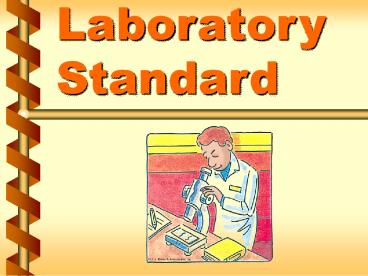Laboratory Standard - PowerPoint PPT Presentation
Title:
Laboratory Standard
Description:
Laboratory Standard Laboratory use of hazardous chemicals Chemical manipulations are carried out on a laboratory scale Multiple chemical procedures or chemicals are ... – PowerPoint PPT presentation
Number of Views:178
Avg rating:3.0/5.0
Title: Laboratory Standard
1
Laboratory Standard
2
Laboratory use of hazardous chemicals
- Chemical manipulations are carried out on a
laboratory scale - Multiple chemical procedures or chemicals are used
1a
3
Laboratory use of hazardous chemicals
- Procedures are not part of, and do not simulate a
production process - Protective laboratory practices and equipment are
available to minimize employee exposure
1b
4
Permissible exposure limits cannot be exceeded
- PEL is the level a person can be regularly
exposed to without adverse effects - Eight-hour time-weighted average
- Ceiling concentration limits
- Skin designation limits
2a
5
Permissible exposure limits cannot be exceeded
- Action level is an exposure level OSHA has
designated for a specific substance - Eight-hour time-weighted average
- Exposures at action level initiate exposure
monitoring, medical surveillance
2b
6
Exposure monitoring
- Measured when there is reason to believe exposure
levels exceed action level or PEL - Performed for substances regulated by an OSHA
standard that requires monitoring
3a
7
Exposure monitoring
- Monitoring may be terminated in accordance with
regulation - Employees must be notified of monitoring results
within 15 working days - Individually
- Posting results in accessible location
3b
8
Chemical Hygiene Plan - Basic operating procedures
- What to do for accidents and spills
- How to avoid routine exposures
- How to choose chemicals
4a
9
Chemical Hygiene Plan - Basic operating procedures
- Where to eat, drink, chew gum, smoke, apply
cosmetics
4b
10
Chemical Hygiene Plan - Basic operating procedures
- How to properly use glassware and equipment
- Hygiene practices upon leaving laboratory
4c
11
Chemical Hygiene Plan - Basic operating procedures
- Proper behavior in laboratory - no horseplay
- How to pipette - no mouth suction
- Appropriate personal apparel and PPE
4d
12
Chemical Hygiene Plan - Basic operating procedures
- Be aware of unsafe conditions - plan ahead,
follow warnings, work under exhaust hoods - Properly dispose of wastes
- Do not work alone when performing hazardous
procedures
4e
13
Chemical Hygiene Plan
- Potential laboratory hazards
- Allergens and Embryotoxins
- Moderate chronic and high acute toxicity
- High chronic toxicity
- Animal work with chemicals of high chronic
toxicity
4f
14
Chemical Hygiene Plan
- Controls to reduce employee exposure
- Engineering controls
- Work practice controls
- Hygiene practices
- PPE
4g
15
Chemical Hygiene Plan
- Ensure that fume hoods function properly
- Employer approval is needed before conducting
some operations, procedures, activities
4h
16
Chemical Hygiene Plan
- Medical examinations and consultation
4i
17
Chemical Hygiene Plan
- Personnel responsible for implementation of
hygiene plan - Chemical hygiene officer
- Chemical hygiene committee
4j
18
Chemical Hygiene Plan
- Provisions for employee protection from
- Select carcinogens
- Reproductive toxins
- Substances with high degree of toxicity
4k
19
Chemical Hygiene Plan
- Provide information about
- Designated areas
- Containment devices
- Safe removal of contaminated waste
- Decontamination procedures
- Review plan annually
4l
20
Training
- Location and availability of MSDSs
- Training is required upon initial assignment,
and prior to new exposure situations
5a
21
Signs and symptoms of exposure
- Each chemical has an MSDS
- Read MSDS to determine signs and symptoms of
exposure
6a
22
Methods of detection of a release
- Monitoring is conducted
- Continuous monitoring devices
- Visual appearances
- Odor of hazardous chemicals
7a
23
Medical consultations/examinations
- Reasons for medical attention
- Care provided by physician without loss of pay
- Care provided at reasonable time and place
8a
24
Medical consultations/examinations
- Information provided to physician
- Chemicals to which employee is exposed
- Exposure conditions
- Signs and symptoms of exposure
8b
25
Medical consultations/examinations
- Physicians written opinion
- Confidentiality of information not related to
exposure
8c
26
Labels
- Labels on incoming containers cannot be
removed or defaced
9a
27
Respirators - meet 1910.134 requirements
- Selection procedures
- Proper fit
- Proper use and care
- Limitations of respiratory protection
10a
28
Recordkeeping
- Records retained for duration of employment plus
30 years - Includes tests and written opinions
11a
29
Summary of main points
- Basic operating procedures
- PPE
- Hazards of chemicals used
- Signs and symptoms of overexposure
12a
30
Summary of main points
- Detection methods of a release, or presence of
chemicals - Permissible exposure limits
- Required monitoring
12b
31
Summary of main points
- Medical examination requirements
- MSDSs and labels
- Respirator use
- Recordkeeping requirements
12c































